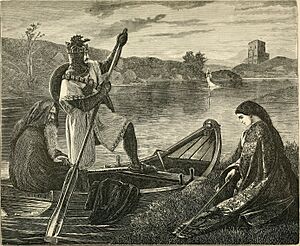Mythology facts for kids



Mythology is a collection of myths from a group of people. These are stories they tell to explain nature, history, and their customs. Mythology can also mean the study of these stories.
A myth is a story that is not true. However, some parts of myths might be based on real events. Myths can be very old or quite new, like urban myths. We learn about them from older people who pass them down. Sometimes, as stories are told again and again, they change. People might change them by mistake or to make them more exciting. Every culture has its own myths. For example, stories about the Greek and Roman gods and goddesses are myths.
Many people once believed in mythological animals and gods. These animals or gods often had power over human life or nature. For instance, the Greek god Zeus controlled lightning and storms. He would create storms to show his anger. In Hindu mythology, thunderstorms were seen as the anger of Indra, the chief of all gods. His powerful weapon was the Vajra, or 'thunderbolt'. It was said that no one could survive an attack from it. Another example is Atum, an Egyptian god. He was believed to be the creator of everything in the world.
Contents
What Are Myths About?
All cultures have created their own myths over time. Mythology includes stories about their history, religions, and how the world began. It also tells tales of their legendary heroes. These stories are very powerful symbolically. This is a main reason why they last so long, sometimes for thousands of years.
The main characters in myths are usually gods, demigods, or humans with special powers. Legends, however, usually feature humans as their main characters. But there are many stories that mix these, like the Iliad, Odyssey, and Aeneid. Rulers and priests often supported myths, and they are closely linked to religion. In fact, many societies saw their myths, legends, and history as true stories from their distant past.
Creation Stories
Creation myths tell how the world was created. These stories happen in a very early time, before the world looked as it does today. Other myths explain how a society's customs, traditions, and taboos (things not allowed) were started.
Folktales are different; people who tell them do not believe they are true. But sometimes, as stories travel to other cultures or as beliefs change, myths can become seen as folktales. Myths and legends can also get mixed together. Their divine characters might become human or half-human, like giants, elves, and faeries.
Creation myths describe the "official" belief about how the world was made. These myths are very different from one society to another. Over the last 300 years, science has grown. This has made people question the power of myths over their minds.
How Historians See Myths
Historians often think myths are about real events. These events might have gained strong symbolic meaning over time. Or they might have been changed, moved in time or place, or even reversed.
Imagine a line. At one end is a simple, factual account of an event. At the other end is a 'mythical' story. As an event moves towards the 'mythical' end, how people think, feel, and talk about it changes. The event might become more important historically. But the actual 'facts' become less important. By the time a story reaches the mythical end, it has "taken on a life of its own." The original facts of the event are almost unimportant.
Related pages
Images for kids
See also
 In Spanish: Mitología para niños
In Spanish: Mitología para niños




